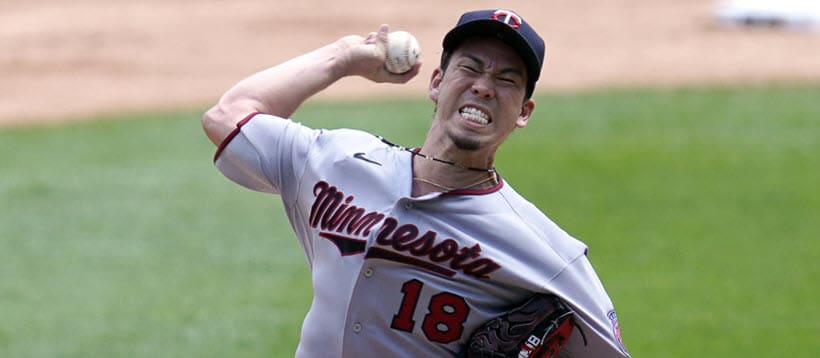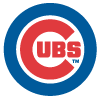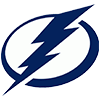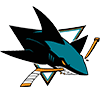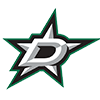I'll state this right off the top: I do not have all the answers, but boy do I have lots of questions about pitching this season. Consider the following list of facts from what we've witnessed already in 2023:
- 37 starting pitchers have struck out 10 or more batters. Kevin Gausman, Shohei Ohtani and Zac Gallen have already done so three times.
- 65 different pitchers have thrown a game where they allowed zero earned runs while pitching at least six innings. Gausman and Gallen are on this list as well, joined by an unlikely partner in Bryce Elder.
- We have seen four complete game shutouts where the pitcher earned a win. They were thrown by Gerrit Cole, Nathan Eovaldi, Sandy Alcantara and Alex Cobb. There were 13 such games in all of 2022.
On the flip side:
- We have 30 instances of a starting pitcher allowing five or more earned runs while working three or fewer innings this season, including two from Shintaro Fujinami.
- Both Luis Cessa and Kenta Maeda allowed double-digit earned runs in a single outing over the past month.
- 39 different starting pitchers have allowed at least 3 home runs in an outing this season, done twice by Ken Waldichuk.
Simply put, starting pitching is off to a rough start in 2023, at a level we have not seen in quite some time. Consider the collective ERAs for starting pitchers the opening month of the season dating back to 2002
I'll state this right off the top: I do not have all the answers, but boy do I have lots of questions about pitching this season. Consider the following list of facts from what we've witnessed already in 2023:
- 37 starting pitchers have struck out 10 or more batters. Kevin Gausman, Shohei Ohtani and Zac Gallen have already done so three times.
- 65 different pitchers have thrown a game where they allowed zero earned runs while pitching at least six innings. Gausman and Gallen are on this list as well, joined by an unlikely partner in Bryce Elder.
- We have seen four complete game shutouts where the pitcher earned a win. They were thrown by Gerrit Cole, Nathan Eovaldi, Sandy Alcantara and Alex Cobb. There were 13 such games in all of 2022.
On the flip side:
- We have 30 instances of a starting pitcher allowing five or more earned runs while working three or fewer innings this season, including two from Shintaro Fujinami.
- Both Luis Cessa and Kenta Maeda allowed double-digit earned runs in a single outing over the past month.
- 39 different starting pitchers have allowed at least 3 home runs in an outing this season, done twice by Ken Waldichuk.
Simply put, starting pitching is off to a rough start in 2023, at a level we have not seen in quite some time. Consider the collective ERAs for starting pitchers the opening month of the season dating back to 2002 in the graph below:
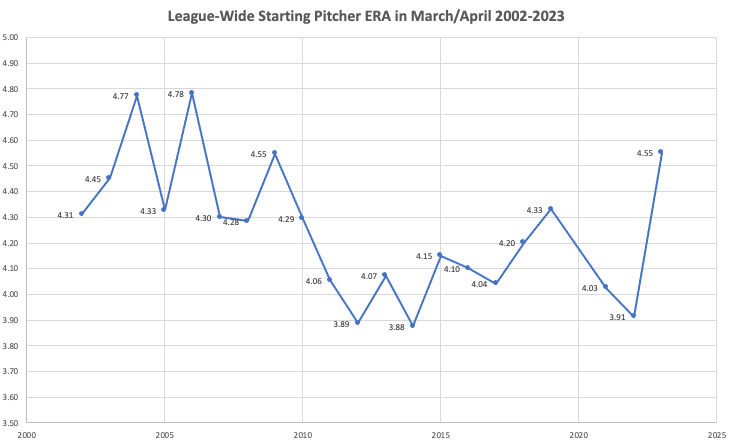
Can the news get worse? I'm glad you asked. The full-season starting pitching ERA tends to get worse as the season goes on. Just 25 percent of the full seasons since 2002 have seen a final ERA for starters lower than what it was in the first month of the season, and the last time that happened (just barely) was in 2018. The last three full seasons and five of the past six full seasons have seen a significant increase as the season wore on:
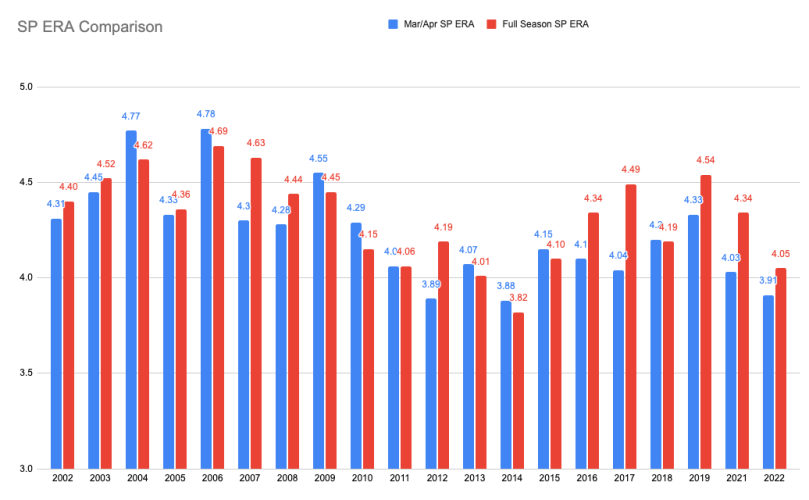
If it feels bad now, we could only be in for rougher waters here soon. A recent piece in The Athletic noted that we saw the highest percentage of pitchers on the IL since at least 2000 last month and the greatest number of starting pitchers over that period. Derek Rhoads from Baseball Prospectus shared some data with Jayson Stark that shows:
- 182 different pitchers went to the IL in the in March/April, which is the highest total since Rhoads began tracking such data
- That is up 14.4 percent from last season and 62.5 percent from 2018
- 67 pitchers hit the IL with elbow-related issues
- 57 pitchers were sent to the IL with shoulder-related issues (not including Kyle Wright who left with shoulder troubles as I am composing this article)
The data shows that offense is up for each of the three standard slash-line categories. League-wide batting average is at its highest point since 2015, on-base percentage is at its highest since 2009 and the league-wide slugging percentage is at its highest since 2009 if we exclude the anomaly of the 2019 bouncy ball:
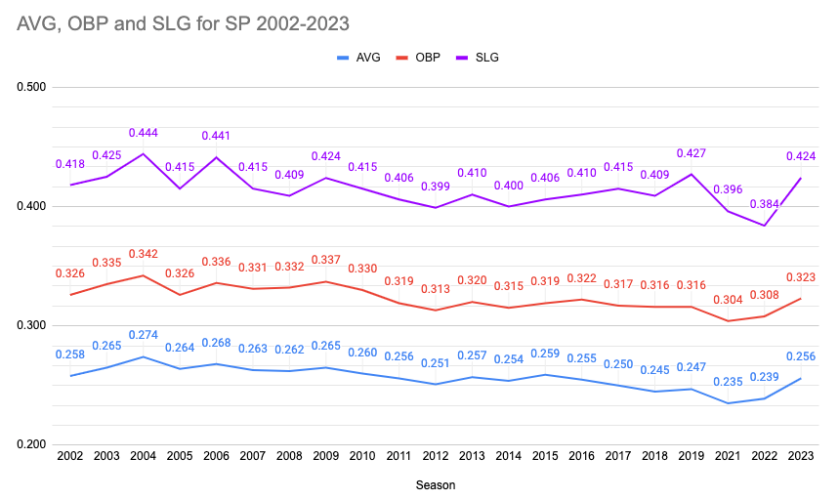
The first week of May gives us little relief as starting pitchers have already allowed 62 homers over the first three days of this week while allowing 134 in all of last week, which includes the games in Mexico City. The Homers per Contact ((HR/(AB-K)) so far this week is 5.1 percent, which is up from 4.5 percent last week and at its highest point since the second week of the season (4.9 percent).
The big question is: what do we do as fantasy managers to mitigate this mess? We have offense up around the league with a livelier run environment than we anticipated due to more runners in scoring position and more runners on base. It's easy to correlate the stolen base action to the new rules, but the jumps in on-base percentage and slugging percentage thus far are tough to credit solely to the new positioning rules or any conspiracy theories with the baseball. We should likely just take these numbers at face value and understand this is our new reality this season, and hopefully the pitching injuries begin to wane before we're left with coach-pitch games or pitching machines by August. We've already seen a high rate of rookie pitchers forced into action earlier than most of us expected simply due to the attrition rate nearly every team has navigated in the first six weeks of the season.
If you are in a mono league, you have the toughest road ahead given the reduced talent pool and the increased level of competition for every free agent starter who shows a modicum of upside. I do not have an NL mono league for reference, but here are the top starting pitcher options available on the free agent wire this weekend in AL LABR and AL Tout:
LABR:
Tout:
Those lists are not as much top names as they are the entirety of available starting pitchers slated to start next week. There will obviously be a bidding war with Miller in Tout, but those with pitching troubles in either league are unlikely to solve those issues through the FAAB process because we have already seen many of the top prospects come up to a mixed bag of success. The next wave would be younger, less experienced and comes with even more risk. The only options I see in mono leagues are either leaning into the pain if your team is struggling and trading what you have left for as much offense as you can acquire or picking up relievers on good teams who can give you good ratios while hopefully vulturing some wins. Names which currently fit that bill include Kyle Nelson, Ryne Stanek, Ron Marinaccio and Bryan Baker. You can also take stabs at relievers on lesser teams whose starters aren't cutting, as the wins must go somewhere. Mason Thompson, Zach Jackson and Cole Ragans each have two wins already this season out of the pen.
15-team mixed leagues have more talent available to employ a streaming strategy, but the names available on the wire are there for a reason. In my TGFBI league, these are the top available starting pitchers this weekend along with their ratios:
| PITCHER | TEAM | ERA | WHIP |
|---|---|---|---|
| Nick Lodolo | CIN | 6.16 | 1.73 |
| Tyler Anderson | LAA | 5.74 | 1.57 |
| Kyle Bradish | BAL | 5.74 | 1.72 |
| Eric Lauer | MIL | 4.40 | 1.53 |
| Sean Manaea | SFG | 7.85 | 1.64 |
| Rich Hill | PIT | 4.18 | 1.39 |
| Dean Kremer | BAL | 6.67 | 1.58 |
There are no saviors out there who will right your all starting pitching wrongs to date, but perhaps you can mix or match the names based on matchups to get what you need. Several names on that list are pitchers many were very much in on during draft season and have already been sent to the waiver wire, so now the acquisition cost is much easier to deal with than it was in March for guys such as Lodolo and Bradish. There is still some good in these names, just not day in and day out.
12-teamers and below, obviously, have it easier than other formats because of the talent available on the waiver wire and the fact that many teams tend to draft stars and scrubs in such formats, which leads to streaming being an essential roster function all season anyhow.
The only other option I see in each league is leaning into the pain, especially if your pitching numbers are rather terrible. If you have one shining light of hope on your roster, trade him for as much offense as you can get and then spend the season streaming relievers so you can hopefully improve your ratios, vulture some wins and collect a few saves while punting strikeouts and pile as much as you can on the offensive ledger. The challenge with such an approach is it takes at least two teams to tango and you are likely not going to be the only team who decides on this strategy. If you want to do this, be first to the market so you have your best options to trade for rather than waiting for another owner to set the market price and limit your roster renovation options.
As Dr. Brown warned us in the 80's, by my calculations, once we hit summer, we are going to see some serious stuff in pitching numbers the way things are looking right now. We are running out of time to adjust our rosters and strategy, but it is not too late.


